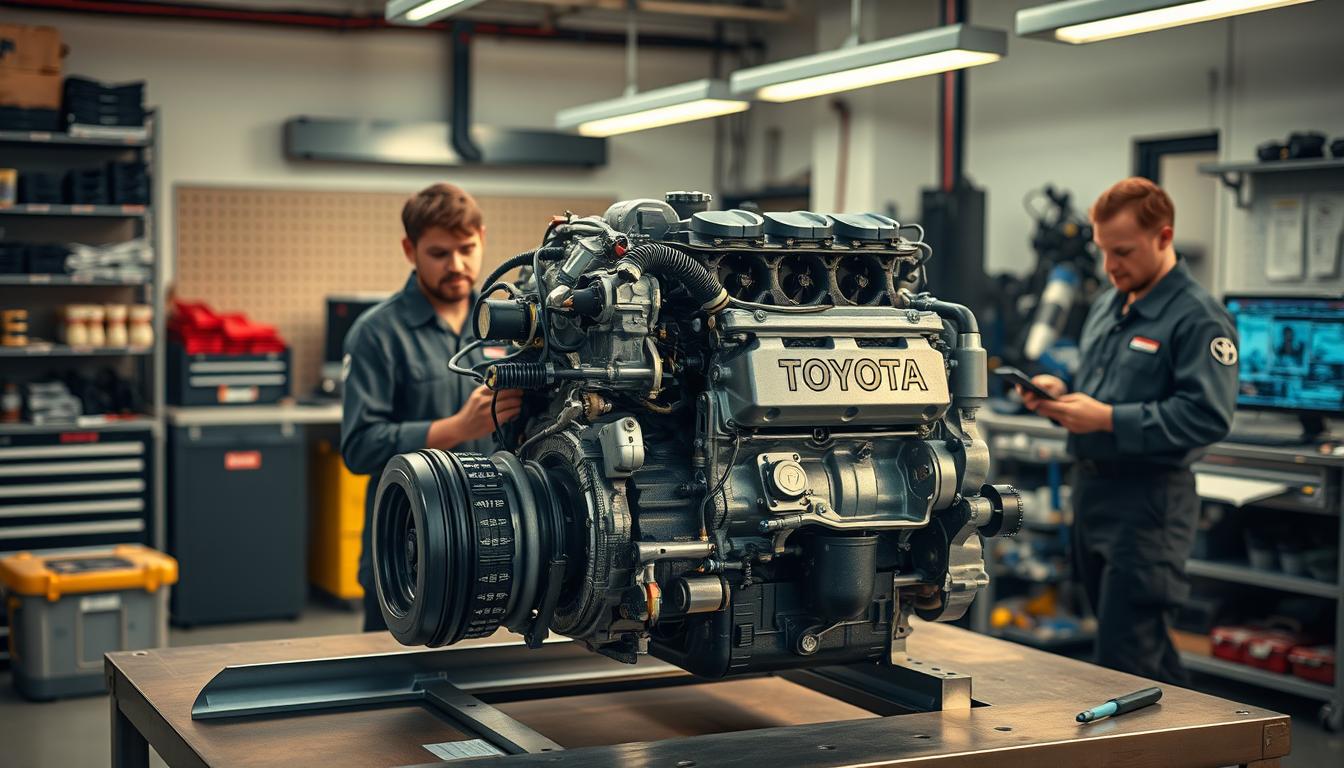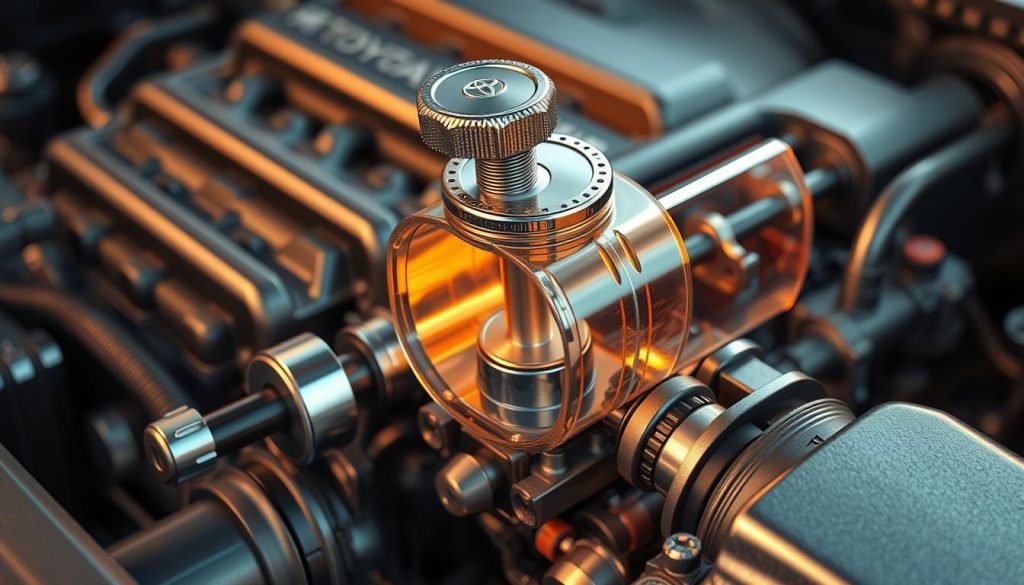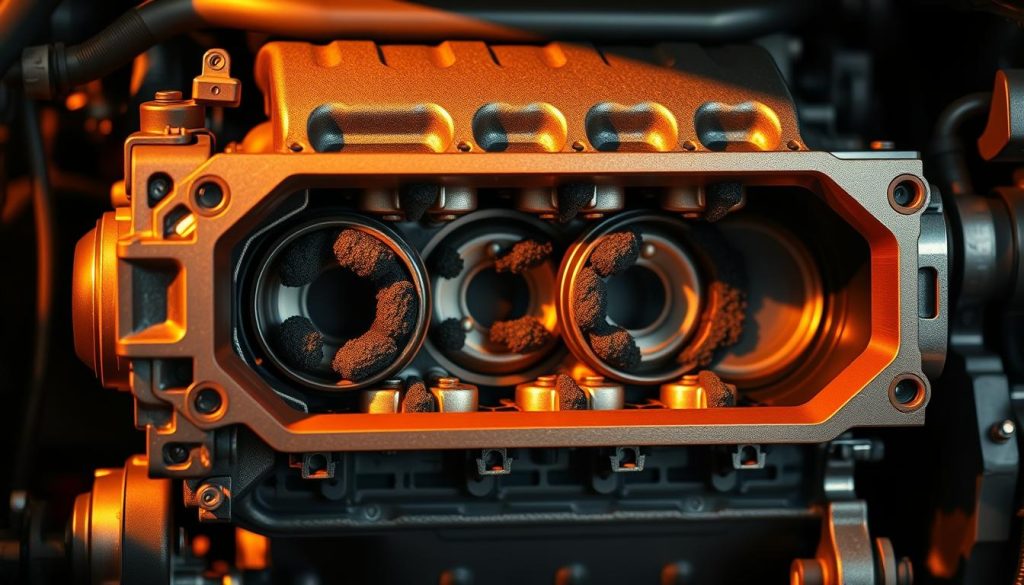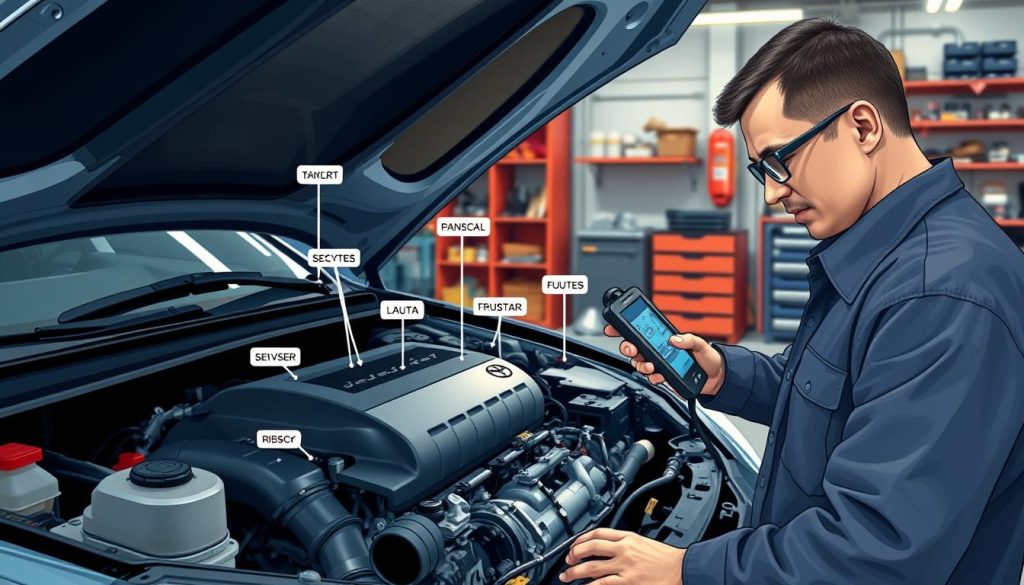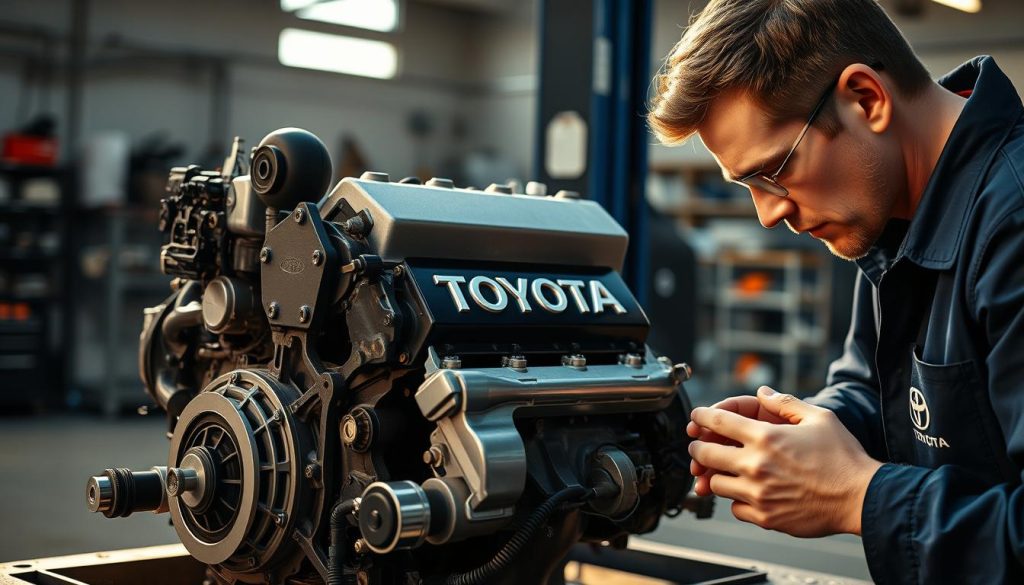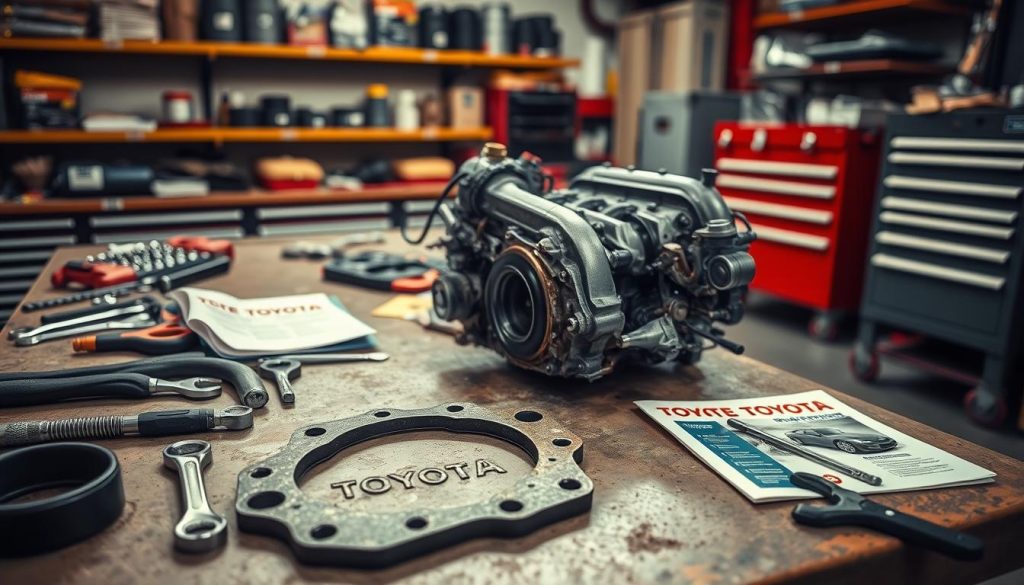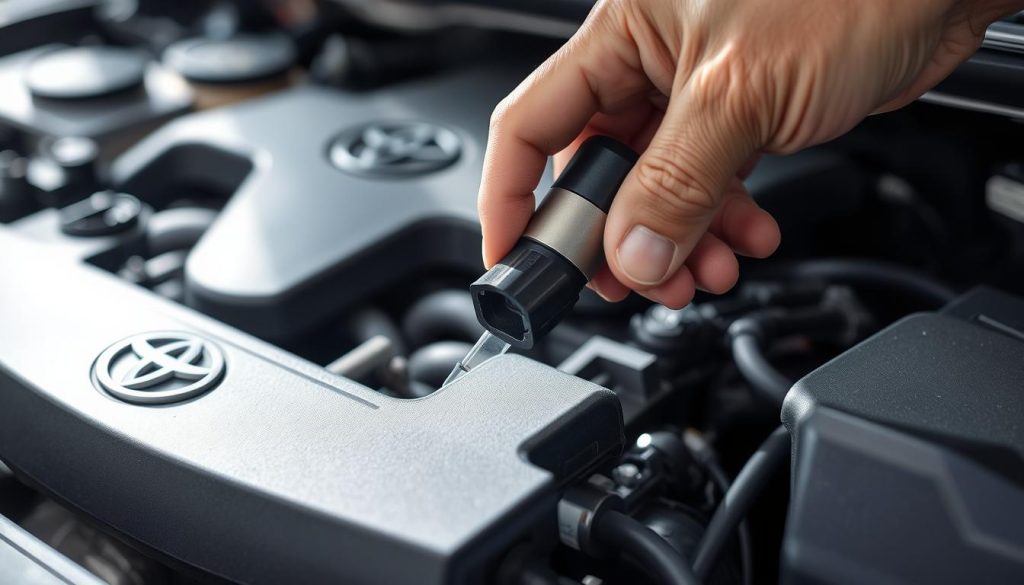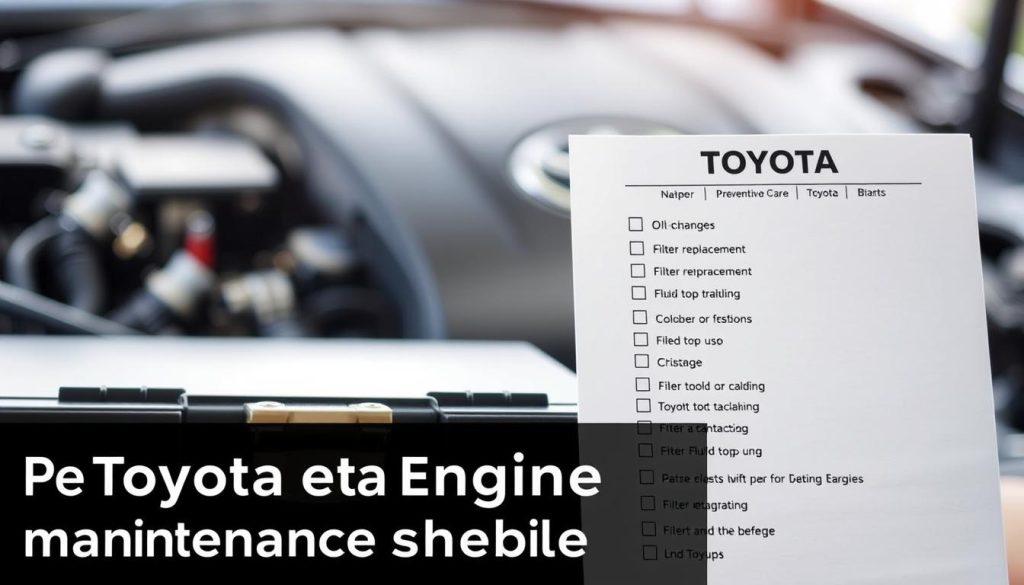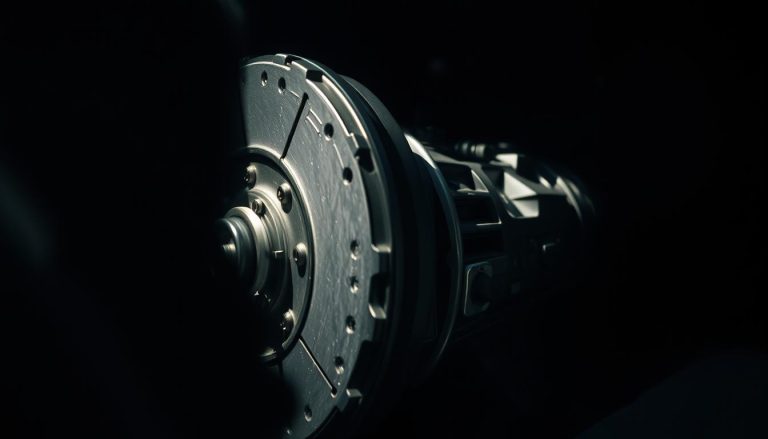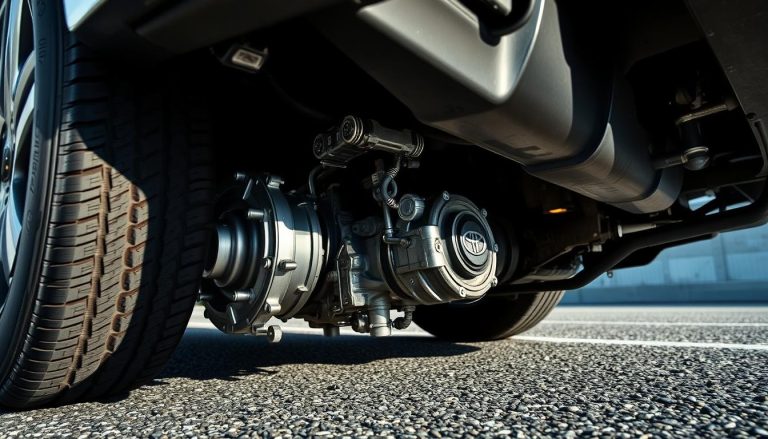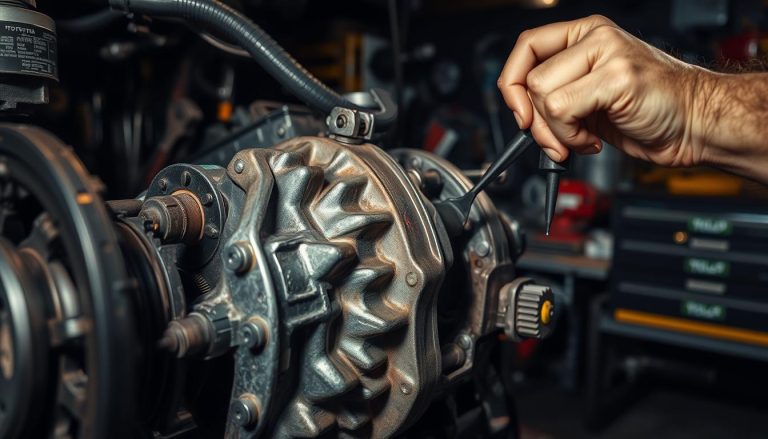Toyota Engine Problems: Causes, Symptoms, and Fixes
Your car starts making strange noises or loses power without warning. These warning signs can be scary for any car owner. Even though Toyotas are known for being reliable, they need regular care to avoid expensive fixes.
Many mechanical problems come from not doing enough maintenance. Skipping oil changes or ignoring fluid replacements can harm your car. Toyota engine failure often happens because of these simple mistakes.
This guide will teach you to spot early warning signs and understand basic car checks. You’ll learn when to fix things yourself and when to call a pro. Engine troubleshooting doesn’t have to be hard with the right info.
We’ll talk about everything from regular Toyota maintenance to spotting serious problems. By the end, you’ll know how to keep your car running well for years.
Key Takeaways
- Regular maintenance prevents most serious mechanical failures and extends vehicle lifespan
- Early warning signs like unusual noises or performance changes indicate possible issues
- Proper fluid replacement schedules are key for top performance
- Basic diagnostic skills help tell apart small problems from big repairs
- Knowing when to seek professional help saves time and prevents costly damage
- Preventive care is cheaper than emergency repairs
Understanding Your Toyota Engine and Warning Signs
Knowing how your Toyota alerts you to engine problems can save you a lot of money. It has built-in sensors that watch engine performance and warn you when something’s off.
The check engine light is your main warning. It’s an amber light on your dashboard linked to your Toyota’s computer. If sensors find engine issues, the light turns on to alert you.
There are other critical warning signs your Toyota shows too. These include:
- Thick, colored smoke from your exhaust pipe
- Unusual knocking or pinging sounds from the engine
- Rough idling or stalling while driving
- Engine running continuously after turning off the key
- Strange vibrations or shaking during operation
When your engine is working right, it makes clear exhaust and runs smoothly. But if it starts making odd sounds or acts strangely, it’s a sign of trouble.
Toyota’s engine diagnostics system is always on the lookout for problems. It checks everything from fuel to emissions, catching issues early to avoid costly repairs.
Never ignore these warning signs when they pop up. What seems small can turn into big engine damage, costing a lot. Paying attention to your check engine light and other signs helps keep your Toyota running well for a long time.
Most Common Toyota Engine Problems You’ll Encounter
Knowing which engine problems affect your Toyota can save you a lot of money. Different Toyota models face unique issues based on their design and when they were made. Understanding these patterns helps you prepare for problems before they cost a lot to fix.
The following breakdown covers the most frequent problems across popular Toyota models. Each generation has specific vulnerabilities that owners should watch out for.
2000-2010 Toyota Camry and Corolla Issues
Oil consumption problems are common in many vehicles from this era. The 2005-2010 Toyota Avalon and 2007-2009 Toyota Camry often burn too much oil. This is due to faulty piston rings and valve seals.
Toyota Corolla issues from this period often involve head gasket failures. Over 10% of Corollas may have head gasket problems after 100,000 miles. These failures can cause coolant leaks and engine overheating.
Older Camry models also have timing belt problems. The interference engines in these vehicles can suffer severe damage if the timing belt breaks unexpectedly.
2011-2020 Toyota Prius and RAV4 Problems
Toyota Prius engine trouble often involves the hybrid system integration. The frequent engine start-stop cycles can stress components like the EGR valve and create carbon buildup issues. Battery cooling system problems also affect engine performance.
Fuel injector problems significantly impact 2006-2009 RAV4 models and 2007-2014 Tundra trucks. These problems cause rough idling, poor fuel economy, and engine misfires. The injectors become clogged with carbon deposits over time.
VVT-i system malfunctions create additional concerns in this generation. The variable valve timing components can fail and trigger check engine lights.
Recent Toyota Highlander and Tacoma Concerns
Modern Toyota engines face direct injection carbon buildup challenges. The 2014-2019 Highlander and 2016-2020 Tacoma models develop carbon deposits on intake valves. This buildup reduces engine performance and fuel efficiency.
Transmission-related engine performance issues also emerge in newer models. The engine and transmission communication problems can cause hesitation during acceleration.
| Model Years | Primary Issues | Affected Components | Typical Mileage |
|---|---|---|---|
| 2000-2010 Camry/Corolla | Oil consumption, head gaskets | Piston rings, valve seals | 80,000-120,000 miles |
| 2011-2020 Prius/RAV4 | Fuel injectors, hybrid systems | EGR valve, injectors | 60,000-100,000 miles |
| 2014-2020 Highlander/Tacoma | Carbon buildup, transmission | Intake valves, sensors | 40,000-80,000 miles |
How to Identify Oil Consumption Problems
Oil consumption issues in Toyota engines can quietly drain your wallet and damage your engine if left undetected. Toyota oil consumption problems affect many models, with some owners seeing a lot of oil loss between changes. Catching these problems early can prevent expensive repairs and keep your vehicle running longer.
Effective engine oil monitoring goes beyond just checking the dipstick. Many Toyota drivers miss the warning signs until it’s too late. Here’s a three-step process to help you spot oil consumption issues before they cost a lot.
Monitor Your Oil Levels
Checking your oil level regularly is key to spotting oil leak detection. Do this at least once a week when the engine is cold and the car is parked on level ground. Wait five minutes after turning off the engine to get an accurate reading.
Normal oil consumption should not exceed one quart between oil changes for most Toyota engines. If you’re adding oil more often, keep track of the dates and amounts. Excessive consumption often means worn piston rings or valve seals that need fixing right away.
Perform the 1,000-Mile Oil Test
The 1,000-mile test gives you a clear picture of your engine’s oil consumption rate. Start with a fresh oil change and note the oil level on your dipstick. Drive 1,000 miles under normal conditions, then check the oil level again using the same method.
Keep detailed records of your findings, including driving conditions and oil brand. Toyota oil problems show up when engines use more than one quart per 1,000 miles. This usually means faulty piston rings and valve seals, common in high-mileage vehicles.
| Oil Consumption Rate | Engine Condition | Action Required |
|---|---|---|
| Less than 1 quart per 5,000 miles | Normal | Continue regular maintenance |
| 1 quart per 2,000-3,000 miles | Moderate wear | Monitor closely, plan for repairs |
| 1 quart per 1,000 miles | Significant wear | Immediate professional diagnosis |
| More than 1 quart per 1,000 miles | Severe internal damage | Major engine repair needed |
Check for External Leaks
External oil leaks are easier to spot than internal consumption. Oil leaks are common in Toyota Sienna and Tacoma models due to worn seals and gaskets. Look for dark spots or stains under your parked vehicle, focusing on the front and center of the engine bay.
Check the valve cover gaskets, oil pan, and rear main seal area for signs of wetness or oil buildup. Fresh leaks are wet and dark, while older ones collect dirt and look crusty. Fixing external leaks quickly prevents oil starvation and environmental damage.
Regularly checking for oil spots under your vehicle helps detect leaks early. Clean your driveway or parking spot to spot new leaks easily. Early detection of both internal consumption and external leaks saves money and prevents engine failure.
Diagnosing Timing Chain and Belt Issues
Timing chain and belt problems are serious Toyota engine issues. They keep your engine’s pistons and valves in sync. If they fail, it can be very costly and dangerous.
The 2000-2006 Toyota Highlander often has timing belt wear issues. A broken belt can cause catastrophic engine damage, costing up to $2,000 to fix. Experts suggest timing belt replacement every 60,000 to 100,000 miles.
“A timing belt failure is like a heart attack for your engine – it happens suddenly and the damage is often irreversible.”
Listening for Timing Chain Rattle
Toyota timing chain rattle makes a distinct sound. Listen for it when the engine is cold. You’ll hear a metallic rattling from the front.
The rattle usually lasts 10-15 seconds after starting. It might also happen during idle or when you accelerate. This sound means the chain or tensioner is failing and needs fixing right away.
Visual Inspection of Timing Components
Start by looking at the engine when it’s off and cool. Remove the upper timing cover to see the timing belt or chain. Look for frayed edges, cracks, or missing teeth on belts.
Check the belt’s tension by pressing down gently. It should deflect about half an inch. Excessive slack means the belt is worn and might fail.
Look at the timing chain for stretched links or damaged guides. Also, check for metal shavings around the timing cover, which can mean internal wear.
Testing Timing Chain Tensioner
The timing chain tensioner keeps the chain tight. Test it by starting the engine and listening for steady sounds. A failing tensioner makes intermittent rattling sounds.
Check the tensioner’s oil pressure by removing the cap. You should see steady oil flow when the engine runs. No oil flow means you need to replace the tensioner.
Use a timing light to check if the timing marks are aligned. Misaligned marks mean tensioner or chain problems that need fixing right away.
Carbon Buildup in Toyota Direct Injection Engines
Carbon buildup is a big problem for Toyota’s direct injection engines. Unlike older engines, Toyota GDI problems happen because fuel goes straight into the combustion chamber. This makes intake valves prone to carbon buildup over time.
Direct injection engines are better at saving fuel and making more power. But, they also need more care. Without fuel flowing over intake valves, engine carbon deposits can build up. This hurts how well the engine runs.
Recognizing Carbon Deposit Symptoms
There are signs that show Toyota carbon buildup in your engine. First, you might notice the engine idling roughly, more so when it’s cold. It might shake or vibrate a lot when starting up.
Another sign is when your Toyota doesn’t accelerate well. It might feel slow when you try to merge onto highways or go up hills. Also, you might see your fuel economy drop because the engine has to work harder.
When your engine hesitates during acceleration, it can feel jerky or stutter. This is because carbon deposits mess with the air-fuel mix needed for smooth running.
DIY Carbon Cleaning Methods
Direct injection cleaning can be done at home with the right steps. Start by adding quality fuel additives made for direct injection engines. Use these every 3,000 miles to keep your engine clean.
To clean intake valves manually, you need to take off the intake manifold. Use special carbon cleaning solvents and soft brushes to gently remove the deposits. Always be careful and follow your service manual’s safety tips.
When engine carbon deposits get really bad, you’ll need a pro to clean them. Walnut shell blasting is a good option. It gets rid of tough buildup without harming the valves.
Troubleshooting Coolant System Problems
Learning to fix Toyota coolant problems saves time and money. It also prevents engine damage. Your cooling system keeps the engine at the right temperature. If it fails, engine overheating can harm your engine quickly.
Spotting early signs helps avoid costly repairs. Steam from the hood is a warning sign. A rising temperature gauge means you need to act fast.
Step-by-Step Coolant Leak Detection
Begin by checking the engine bay for leaks. Look for green, orange, or pink fluid puddles. These colors mean you have a coolant leak.
Examine hoses for cracks or swelling. Focus on where hoses connect to the radiator and engine. Coolant leak repair often means replacing these hoses.
Use a cooling system pressure tester to find small leaks. Only remove the radiator cap when the engine is cool to avoid burns.
Testing Thermostat Function
Toyota thermostat issues can cause overheating and bad fuel economy. Watch the temperature gauge during warm-up. It should rise and then stabilize.
A stuck-closed thermostat overheats quickly. A stuck-open one keeps the engine too cool. Both can harm your engine.
Test the thermostat in hot water if you think it’s not working right. It should open at the temperature marked on the housing.
Water Pump Inspection Guide
Listen for strange noises from the water pump area. Grinding or squealing sounds mean the pump needs to be replaced.
Check the water pump weep hole for coolant leaks. Any moisture means the pump needs to be replaced.
Check the water pump pulley for looseness. If it moves, it’s a sign of worn bearings. This can leave you stranded with a hot engine.
Complete Engine Diagnostic Procedure
Modern Toyotas have advanced diagnostic tools for Toyota engine diagnostics. They have sensors that watch engine performance all the time. If something goes wrong, the check engine light turns on to warn you.
Fixing engine problems involves three steps. This method is efficient and saves money. Each step gives you more info about your engine’s health.
Visual and Audio Inspection
Begin by checking the engine visually. Look for leaks, cracked hoses, or worn belts. Also, inspect connections and wiring for damage.
Listen to your engine while it’s running. Strange sounds can signal problems. Grinding, knocking, or squealing noises mean different issues.
Check the air filter, oil, and coolant levels. These basic checks can find common problems. Take photos of anything odd for later reference.
OBD-II Code Reading
Use an OBD-II scanner to read trouble codes. These OBD-II codes tell you about engine issues. Modern Toyotas keep both current and pending codes.
Common codes include P0171 for lean fuel and P0300 for misfires. Write down all codes before clearing them. Some codes are related and need to be fixed together.
Look up each code’s meaning and possible causes. Knowing this helps you focus your diagnostic efforts.
Performance Testing
Engine performance testing confirms issues found earlier. Test how the engine responds during acceleration and idle. Also, check its smoothness at different RPMs.
Test fuel pressure if you think there’s a fuel system problem. Do compression tests for cylinder issues. These tests give you solid data about your engine’s condition.
Keep a record of all test results. Compare them to Toyota’s standards. This method helps you make smart repair choices or talk to mechanics effectively.
Fixing Engine Knock and Pinging Sounds
Toyota engine knock and pinging sounds are warning signs of fuel combustion problems. These issues can harm your engine if not fixed. The sounds occur when fuel ignites too early, causing pressure waves that damage engine parts.
High-performance Toyotas, like the Supra, are more likely to knock when using low-grade fuel. They need premium fuel to avoid premature ignition. Fixing these sounds quickly can save thousands in engine repairs.
Identifying Different Engine Noises
Knowing how to identify Toyota engine noises is key to diagnosing problems. Each sound has its own characteristics that point to specific issues.
Engine knock sounds like marbles in a can. It gets louder when you accelerate. This happens when fuel ignites before the spark plug fires.
Rod bearing noise is a deeper knock that gets louder with RPM. This is a serious problem that needs quick attention to avoid engine failure.
Valve train noise sounds like ticking or tapping from the top of the engine. It usually means worn valve lifters or low oil pressure.
| Noise Type | Sound Description | When It Occurs | Severity Level |
|---|---|---|---|
| Engine Knock | Metallic rattling | During acceleration | High |
| Rod Bearing | Deep knocking | Increases with RPM | Critical |
| Valve Train | Light ticking | Constant at idle | Moderate |
| Engine Pinging | Sharp metallic ping | Under load | High |
Adjusting Fuel Octane Requirements
Knowing your fuel octane needs prevents engine pinging and protects your Toyota. Octane rating shows how well fuel resists premature ignition.
Most Toyotas run fine on regular unleaded fuel (87 octane). But turbocharged and high-compression engines need premium fuel (91-93 octane) to avoid knocking.
Switching to higher octane fuel often stops knocking right away. Try premium fuel for a tank to see if the noise goes away. If knocking persists with premium fuel, there might be mechanical issues.
The link between compression ratio and octane is key – higher compression engines squeeze the fuel-air mixture more. This creates heat and pressure that can cause lower octane fuels to ignite too soon.
Some Toyota engines have knock sensors that detect pinging and adjust timing. When these sensors fail, the engine can’t handle low-octane fuel, leading to damage.
Repairing Oil Leaks and Gasket Problems
Oil leaks are a big headache for Toyota owners. They affect many models, like the Toyota Sienna and Tacoma. Regular inspection under your vehicle catches leaks early, saving money on repairs.
Most oil leak repairs focus on three main areas. Each needs different tools and skills. Knowing this helps you choose between DIY or professional help.
Valve Cover Gasket Replacement Steps
Replacing the valve cover gasket is a common fix. Start by taking off the engine cover and air intake. Clean the area well before starting.
Here are the key steps:
- Remove spark plug wires and ignition coils carefully
- Unbolt the valve cover using the right sequence
- Scrape off old gasket material completely
- Put in a new gasket with the right torque
This job costs $150-300 in parts and takes 2-3 hours. Use genuine Toyota gaskets for the best results.
Oil Pan Gasket Repair Guide
Fixing the oil pan gasket is more complex than valve covers. You’ll need to lift the vehicle and drain the engine oil first. Some models need exhaust system removal for access.
Get professional help if you don’t have the right lifting gear. The job involves removing many bolts and supporting the engine. Improper installation can cause serious damage.
Professional repair costs $400-800, depending on your Toyota model. DIY saves money but needs advanced skills and tools.
Rear Main Seal Diagnosis
Rear main seal leaks show up as oil spots under the transmission. These leaks get worse over time and need quick fixing. Distinguished from other leaks by their location behind the engine.
This repair often means removing the transmission. Professional service costs $800-1,500 due to the labor involved. Catching these leaks early prevents expensive damage to the transmission.
Spark Plug and Ignition System Repairs
Your Toyota’s ignition system is key to engine performance. It turns electrical energy into the spark needed for each combustion cycle. If it fails, you might see reduced fuel economy, rough idling, and trouble starting. Toyota cars use either traditional distributor systems or advanced coil-on-plug designs.
Keeping your ignition system in check can save you from expensive repairs later. Most Toyotas need spark plug replacement every 30,000 to 100,000 miles. This depends on the plug type and engine.
Testing Individual Ignition Coils
Testing ignition coils is important to catch problems early. Start by finding each coil on your Toyota engine. Newer models have coils right on each spark plug.
Use a digital multimeter to check coil resistance. Primary resistance should be 0.5 to 2.0 ohms, and secondary should be 6,000 to 15,000 ohms. If these values are off, the coil is failing.
Look out for engine misfiring, rough idle, or slow acceleration. These signs often mean a coil needs fixing right away.
Spark Plug Gap and Replacement
Spark plug gap is critical for your Toyota engine’s performance. Most Toyotas need gaps of 0.028 to 0.044 inches. Always check your owner’s manual for the exact gap for your vehicle.
When replacing spark plugs, look at each plug’s condition. Black, oily deposits mean the fuel mixture is too rich. White, chalky residue suggests lean conditions or overheating.
Replace plugs with the right torque – usually 18-22 foot-pounds for most Toyota engines. Too tight can damage threads, while too loose causes misfiring.
Ignition Wire Inspection
Older Toyotas with distributor systems need regular ignition wire checks. Look for cracks, burns, or corrosion that can cause electrical issues.
Test wire resistance with a multimeter. It should be less than 10,000 ohms per foot of length. Higher readings mean the wire is damaged and needs replacing.
When replacing ignition wires, do it one at a time to keep the firing order right. Make sure new wires are away from hot exhaust and sharp metal edges.
Mass Air Flow Sensor Maintenance
Knowing how to care for your Toyota’s mass air flow sensor can save you money and boost fuel efficiency. This key part measures air to mix it right with fuel. But, when it gets dirty, it can lead to rough idle, poor acceleration, and less fuel efficiency.
Problems with the mass air flow sensor often start slowly. You might feel your car hesitate when you speed up or see the check engine light. Regular upkeep keeps your Toyota running well and avoids costly fixes later.
Cleaning MAF Sensor Properly
Cleaning your Toyota MAF sensor needs care because of its sensitive parts. Always unplug the battery first. Then, take out the sensor carefully to avoid breaking the housing.
Only use MAF sensor cleaner spray – don’t use carburetor cleaner or other harsh chemicals. Spray the sensing wire lightly from different sides. Make sure it’s dry before putting it back.
Safety first: Clean in a place with good air flow and wear safety glasses. The parts inside are very delicate and costly to fix if they break.
When to Replace vs Clean
Cleaning is good for light dirt and regular upkeep. But, if cleaning doesn’t fix the problem, you need to replace the sensor.
Get a new Toyota air flow sensor if you see damage, a cracked housing, or error codes keep coming back after cleaning. Good replacement sensors cost $150-300 but fix your engine’s performance.
Changing your air filter often helps keep the MAF sensor clean. It’s a simple way to prevent most problems.
Fuel System Cleaning and Repair
Toyota fuel system cleaning helps avoid expensive engine fixes and boosts performance. It ensures your engine gets the right amount of clean fuel at the right pressure. If your system fails or gets dirty, you might see less power, rough idling, and poor fuel use.
Models like the 2006-2009 RAV4 and 2007-2014 Tundra often face fuel system problems. Owners often report issues like rough idling and lower fuel efficiency. Some see a 20% drop in fuel economy when injectors get clogged.
Testing Fuel Pump Pressure
First, check if fuel pump problems are causing issues. Use a fuel pressure gauge on the test port of your fuel rail. Turn the ignition to “on” without starting the engine.
Most Toyotas need 44-46 PSI fuel pressure. If it’s below 40 PSI, your fuel pump might be failing. Symptoms include hard starting and losing power when accelerating.
Injector Service Steps
Fuel injector cleaning can improve performance and fuel economy. Carefully remove the fuel rail and injectors. Use specialized cleaning fluid and tools to clean them.
Professional cleaning is best for severe clogs. DIY kits work for minor buildup. Replace injectors that don’t clean up or show electrical issues.
Filter Replacement Process
Your Toyota fuel filter keeps gasoline clean before it reaches the engine. Most Toyotas have in-tank filters that last 60,000-100,000 miles. Some older models use inline filters, needing replacement every 30,000 miles.
| Toyota Model | Filter Type | Replacement Interval | Typical Cost |
|---|---|---|---|
| Camry 2007-2017 | In-tank | 100,000 miles | $150-250 |
| Corolla 2009-2019 | In-tank | 80,000 miles | $120-200 |
| RAV4 2006-2012 | Inline | 30,000 miles | $80-120 |
| Tundra 2007-2014 | In-tank | 100,000 miles | $200-300 |
Regular fuel system care stops expensive engine damage. Clean systems run better and last longer than neglected ones.
Toyota Engine Problems Prevention Strategy
Preventing engine problems is key to avoiding expensive repairs and breakdowns. Regular maintenance can reduce the likelihood of engine failure by as much as 70%. Simple steps like timely oil changes and fluid checks can prevent costly repairs later on.
Following your owner’s manual is the first step in preventive engine maintenance. Check fluid levels monthly and fix small issues before they grow. This approach saves time and money.
Creating Your Maintenance Schedule
Your Toyota maintenance schedule should fit your driving habits. Standard schedules work for most drivers, but extreme conditions need more frequent checks. This includes stop-and-go traffic, extreme temperatures, and frequent towing.
Make a schedule that matches your vehicle’s age and how much you use it. Newer Toyotas might stick to factory schedules, while older ones need more frequent service. Keep track of your maintenance in a logbook or app for consistency.
Quality Parts and Fluids Selection
Choosing quality parts is vital for your engine’s life. Toyota OEM parts are the best choice, but OE-equivalent parts are also good. Stay away from cheap aftermarket parts for critical engine parts.
Pick engine oils that meet Toyota’s standards for your model. The wrong oil can cause wear or poor performance. Quality coolants and filters also protect your engine.
Early Warning Sign Recognition
Learning to spot engine changes early is important. Listen for odd noises, watch for performance drops, and check fluid levels. Early detection saves money and prevents major engine failures.
Set up a simple monthly check routine. Check oil levels, listen to the engine, and watch for dashboard lights. These engine maintenance tips help you stay ahead of problems.
Prevention is cheaper than repair. A $50 oil change can save thousands in engine damage. Stay on top of your maintenance, and your Toyota will serve you well for years.
Conclusion
Knowing your engine’s needs makes Toyota ownership better. Many vehicles face engine problems, but they don’t have to ruin your drive. Most issues start slow and give you warning signs.
Regular maintenance is key. Simple tasks like checking oil and listening for odd sounds can prevent big problems. With care, your Toyota engine can last for hundreds of thousands of miles.
Preventing engine problems starts with knowing what to look for. Now you can spot issues early. Keep this guide close and refer to it when you notice something off. Early action saves money and keeps your Toyota running smoothly.
Even the most reliable engines need some TLC. Regular oil changes, coolant flushes, and spark plug replacements are small costs for big benefits. If you notice something wrong, don’t hesitate to get it checked by a pro.
Your Toyota can be a reliable companion for years. Stay on top of maintenance and address problems quickly. With the right care, your engine will prove why Toyota is known for reliability.
FAQ
What are the most common engine problems in Toyota Camry and Corolla models from 2000-2010?
Common issues include excessive oil use and head gasket failures. These can cause coolant leaks and overheating. Timing belt problems also occur, leading to engine damage if not fixed quickly.
These models often burn oil due to worn piston rings and valve seals.
How do I know if my Toyota engine is consuming too much oil?
Check your oil level often and do a 1,000-mile oil test. If more than one quart is used every 1,000 miles, it’s a big problem. Always check oil when the engine is cold and on level ground.
What does timing chain rattle sound like in a Toyota engine?
A timing chain rattle sounds like a metallic noise, often heard when starting the engine cold. It might continue at idle. This noise usually comes from the engine’s front and means the chain or tensioner is failing, needing quick attention.
How can I tell if my Toyota has carbon buildup in the direct injection engine?
Look for signs like a rough idle, less power when accelerating, poor fuel economy, and engine hesitation. These issues get worse over time, affecting Toyota models with direct injection systems.
What should I do if my Toyota’s check engine light comes on?
Use an OBD-II scanner to check the codes right away. Don’t ignore the light; it warns of engine problems. Common codes include P0171 (lean fuel mixture) and P0300 (random misfires), needing quick diagnosis.
How do I detect coolant leaks in my Toyota engine?
Look for puddles under your car and check for stains around the radiator and hoses. Also, watch your coolant level. Internal leaks can cause white exhaust smoke or milky oil. Fix coolant leaks fast to avoid overheating and damage.
When should I replace spark plugs in my Toyota?
Spark plugs need replacing every 60,000-100,000 miles, depending on the type. Iridium plugs last longer than copper ones. Replace them for misfiring, rough idle, or poor fuel economy. Always use the correct gap for your model.
What causes engine knock in Toyota vehicles?
Engine knock is often from low octane fuel, carbon buildup, or wrong ignition timing. Some Toyota engines, like turbocharged ones, need premium fuel to avoid knocking. Fix knocking quickly to prevent engine damage.
How do I clean a mass air flow sensor on my Toyota?
Clean the MAF sensor with spray cleaner (avoid touching the sensing parts with your hands). Let it dry completely before putting it back. Clean it for rough idle, poor acceleration, or low fuel economy. Also, replace the air filter often to keep the sensor clean.
What are signs of a failing fuel pump in a Toyota?
Look for hard starting, engine stalling, power loss, and a whining noise from the fuel tank. Test the fuel pressure with a gauge. Most Toyotas need 40-60 PSI. A failing fuel pump needs to be replaced right away.
How often should I change my Toyota’s timing belt?
Toyota suggests replacing the timing belt every 60,000-90,000 miles, based on your model. Interference engines can be severely damaged if the timing belt breaks. Always replace the water pump and tensioners at the same time.
What’s the difference between valve cover gasket and oil pan gasket leaks?
Valve cover gasket leaks are at the engine’s top and can cause smoke. Oil pan gasket leaks are at the bottom and create puddles. Valve cover gaskets are easier to replace yourself.
How do I prevent carbon buildup in my Toyota’s direct injection engine?
Use Top Tier gasoline and add fuel system cleaners regularly. Avoid idling too much and drive at highway speeds to burn off deposits. Consider walnut blasting every 60,000-80,000 miles for severe buildup.
What maintenance schedule should I follow for my Toyota engine?
Follow Toyota’s severe service schedule for stop-and-go traffic, extreme temperatures, or dusty driving. This means more frequent oil changes, air filter replacements, and coolant system checks. Use only recommended fluids and OEM or OE-equivalent parts.
When should I seek professional help for Toyota engine problems?
Get professional help for timing chain issues, internal coolant leaks, major oil leaks, or engine disassembly problems. Also, seek help if you’re not sure about diagnostics or if problems persist after basic maintenance.

